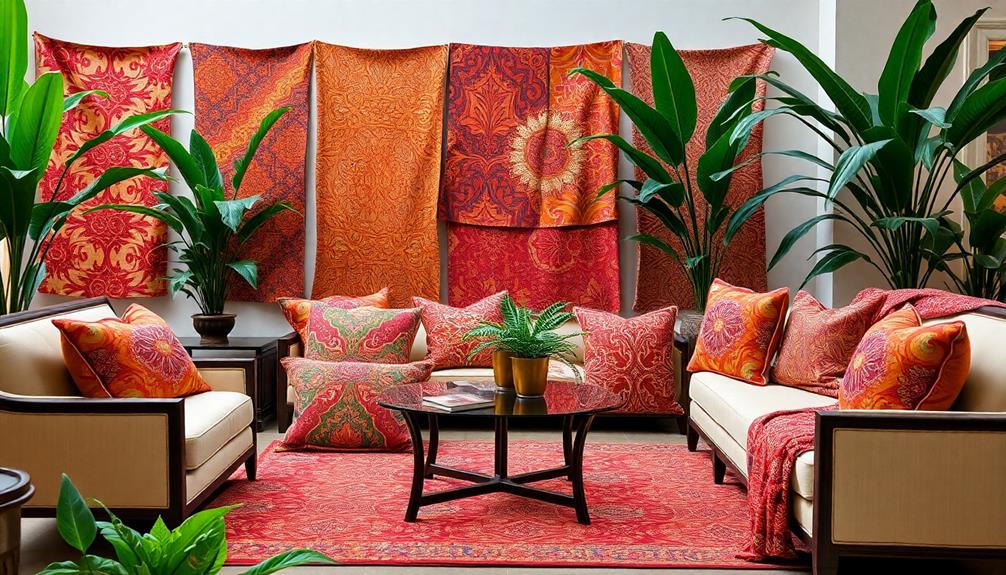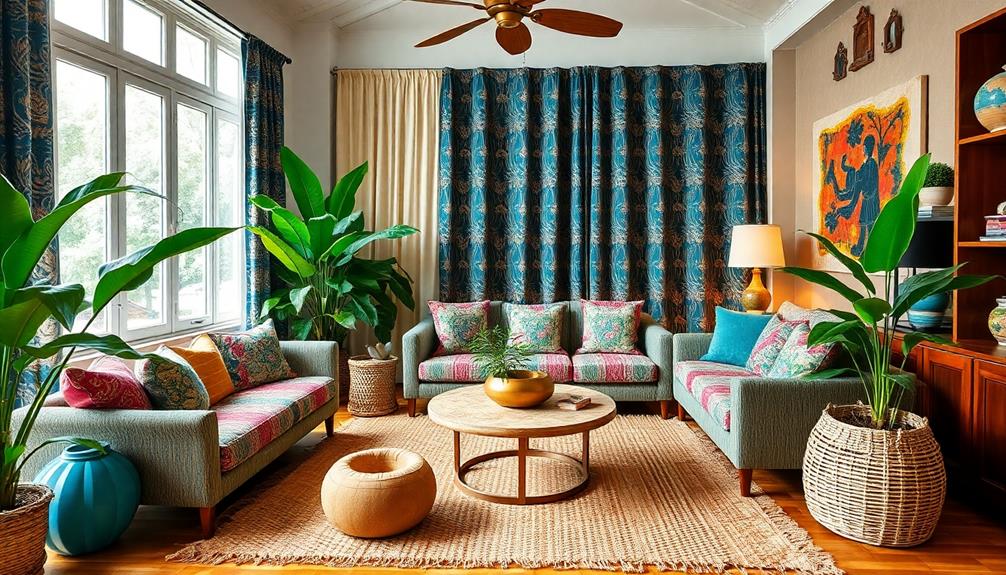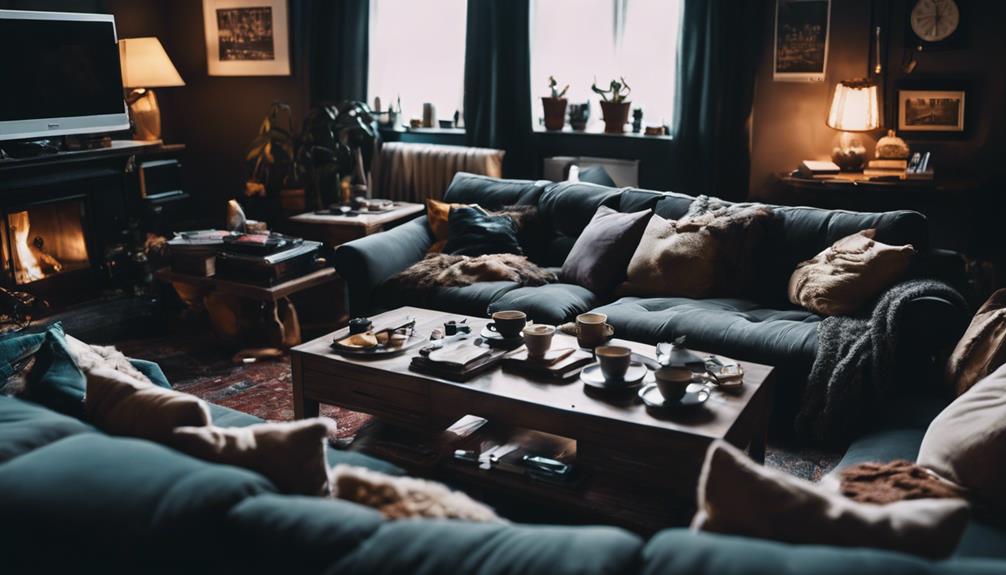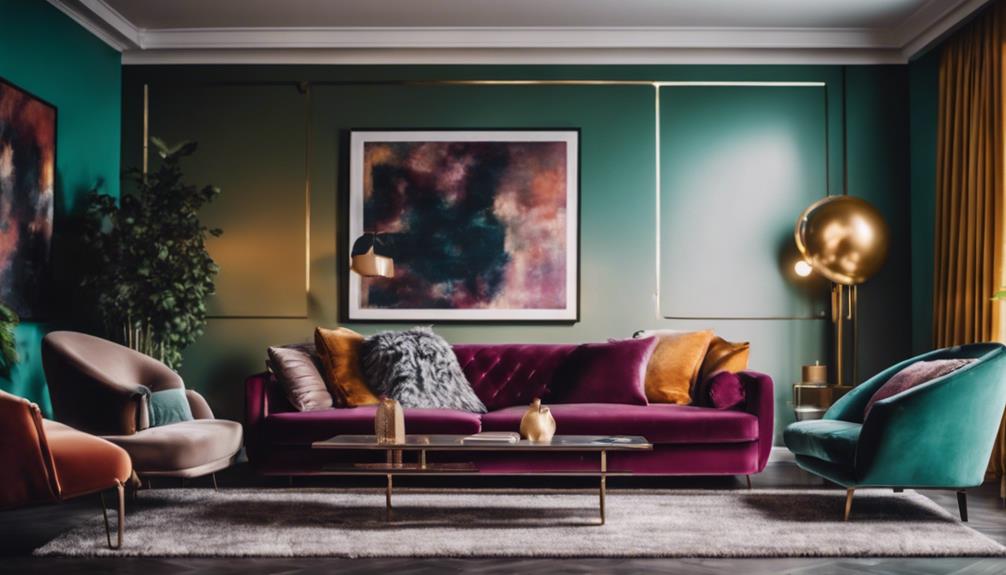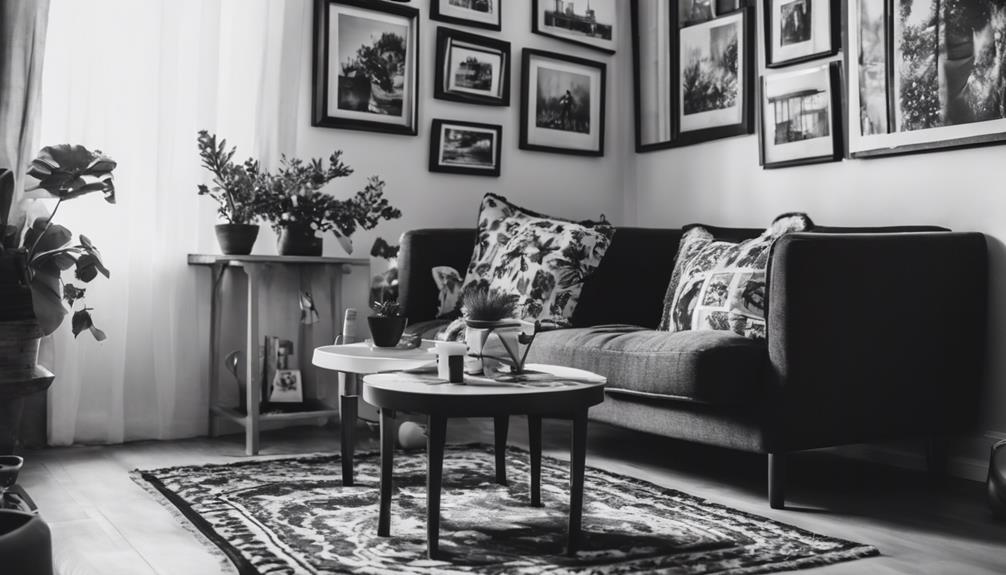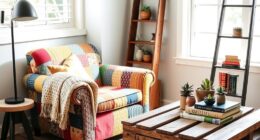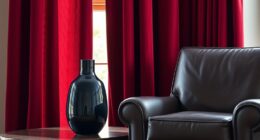Indonesian textiles are vibrant elements that can completely change the atmosphere of your home. Consider using Batik for its intricate patterns or Ikat for bold, eye-catching designs. Songket adds a touch of luxury with its gold and silver threads, while Tenun tells stories through its handwoven textures. Endek offers vibrant colors to complement any modern decor, and Kain Perca brings a sustainable patchwork charm. Sumba Weaving showcases beautiful geometric artistry, and Lombok Textiles connects you to exotic island inspiration. Each fabric brings a unique touch to your space, making it unforgettable. Explore more options to enhance your decor further! Moreover, combining different textures and patterns can create a dynamic yet cohesive look, blending traditional charm with modern elegance. Whether you choose a single statement piece or layer multiple fabrics, using Indonesian fabric to enhance your decor will infuse your space with culture and craftsmanship. Don’t hesitate to experiment – each fabric adds a distinct story and aesthetic to your home. The possibilities are endless when incorporating Indonesian textiles into your home decor. Whether you drape a Batik throw over your couch or layer Ikat pillows for added texture, each fabric serves as both a visual and tactile element. By integrating these rich, cultural pieces into your design, you seamlessly merge heritage and modern sensibility, creating a truly unique space.
Key Takeaways
- Batik: This intricate wax-resist fabric adds vibrant stories and cultural significance, perfect for enhancing walls or upholstery in modern spaces.
- Ikat: Featuring bold patterns and colors, Ikat textiles create a striking visual impact, making them ideal for statement cushions or curtains.
- Songket: Luxurious gold and silver threads elevate any room's elegance, ideal for decorative throws or accent pieces in a sophisticated decor scheme.
- Endek: Crafted with natural dyes, Endek textiles embody Bali's design culture, perfect for adding a touch of tradition to contemporary interiors.
- Kain Perca: Unique and sustainable, these fabric scraps transform into personalized decor items, promoting vibrant and eco-friendly home aesthetics.
Batik: Timeless Elegance
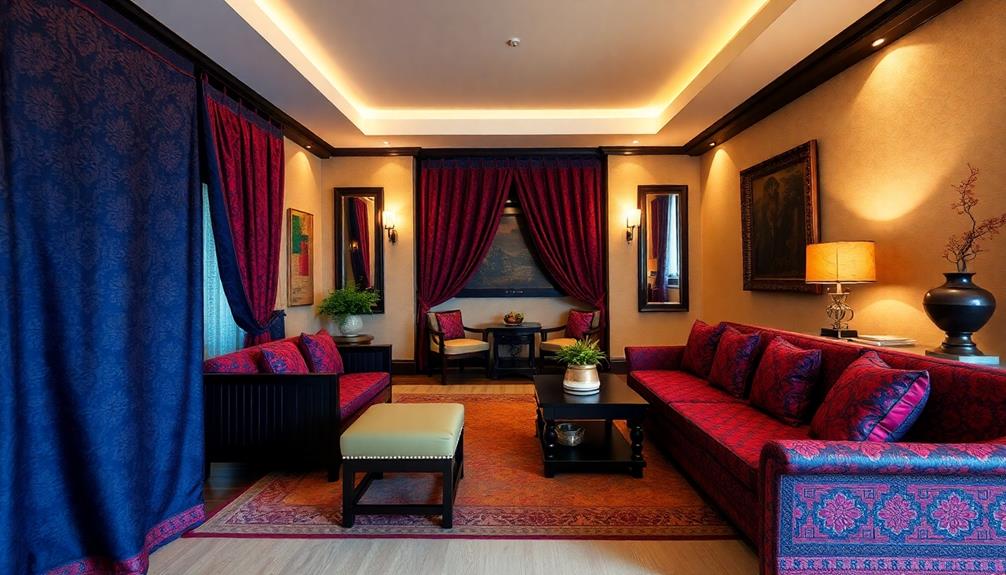
When you explore the world of Indonesian textiles, batik stands out as a timeless art form that captivates with its intricate designs and rich cultural significance. This traditional craft, rooted in centuries of history, showcases the exquisite technique of wax-resist dyeing.
Skilled artisans painstakingly apply hot wax to fabric, creating elaborate patterns that come to life when dyed. Once the wax is removed, you're left with stunning, multi-colored designs that tell a story.
Traditional artistry shines through in every piece, reflecting the vibrant culture of Indonesia.
Batik fabrics often feature symbolic motifs, each representing important aspects of life, nature, and spirituality. This not only makes them visually appealing but also deeply meaningful.
When you take a look at batik textiles, you'll find a vibrant array of colors and patterns perfect for clothing, home decor, or table linens, adding elegance and authenticity to your space.
In Bali, Indonesia, Ubud is a hub for batik craftsmanship. Here, artisans blend traditional techniques with modern innovation, producing high-quality textiles that celebrate this rich heritage.
Whether you're looking to enhance your wardrobe or elevate your home's vibe, batik fabrics offer a beautiful way to embrace Indonesian culture.
Ikat: Bold Patterns
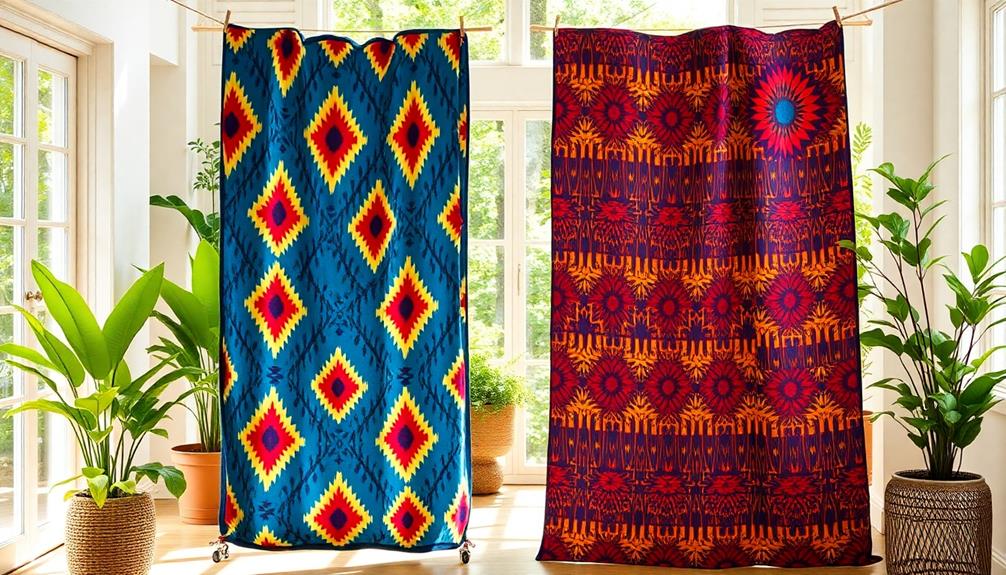
Ikat textiles command attention with their bold patterns and vibrant colors, showcasing a unique resist-dyeing technique that sets them apart from other fabrics. This method involves dyeing the yarns before weaving, resulting in striking designs that often feature blurred edges.
You'll find a variety of patterns, from geometric shapes to intricate floral motifs, each reflecting the cultural significance and regional identity of Indonesia. These eye-catching fabrics not only enhance your decor but also offer a glimpse into the craftsmanship of local artisans, supporting traditional practices and Indonesian Decorative Pillows that bring comfort and style.
Regions like Sumba and Bali produce distinct styles of ikat, often utilizing natural dyes sourced from local plants. This not only enhances the authenticity of the textiles but also connects them to the environment.
Imagine incorporating these stunning fabrics into your home decor; they can transform cushions, curtains, and wall hangings, infusing your space with ethnic charm and artistic flair.
Creating ikat textiles is a labor-intensive process that can take several months to finish a single piece. This craftsmanship not only results in valuable artisanal products but also supports local artisans, preserving the traditional textile art.
Songket: Luxurious Weaves

When you explore songket, you'll appreciate the traditional weaving techniques that create its stunning textures and patterns.
The vibrant color palettes, often enhanced by gold or silver threads, bring a luxurious feel to any space in your home.
Incorporating elements like the Face Indonesian Decor Mask can further enhance the cultural aesthetic.
Embracing songket not only adds beauty but also connects you to a rich cultural heritage.
Traditional Weaving Techniques
Songket, a stunning traditional fabric from Indonesia, captures the eye with its intricate patterns and luxurious threads. This fabric is characterized by the use of gold or silver threads woven into a silk or cotton base, creating a striking visual appeal.
The weaving technique employed in songket is the supplementary weft method, where additional threads are interlaced to form raised patterns. This results in a beautiful texture and depth that truly stands out. The artistry behind songket not only showcases the talent of skilled artisans but also reflects the rich cultural heritage and traditions of Indonesia, similar to the significance of Indonesian decor masks that enhance home aesthetics.
Originating from various regions like Bali, Sumatra, and Java, each area brings its unique styles and motifs, reflecting the rich local culture and heritage. The production of songket is labor-intensive, requiring skilled artisans who may spend months crafting a single piece.
This dedication to craftsmanship makes songket a highly valued textile in Indonesian culture. Traditionally, songket is reserved for significant cultural events such as weddings and festivals, symbolizing wealth and status.
However, its artistic beauty has also made it a popular choice for home decor. Incorporating songket into your space not only elevates its vibe but also connects you to the rich traditions of Indonesia.
Vibrant Color Palettes
The vibrant color palettes of songket fabrics elevate any space, offering a stunning range that can transform your home decor. These traditional Indonesian textiles shine with rich jewel tones and bright, bold hues, making them versatile enough to complement various styles, from modern minimalist to bohemian chic.
Incorporating songket into your decor aligns beautifully with natural materials like wood and stone, enhancing the overall aesthetic of Balinese-inspired interiors.
Each piece of songket is a unique work of art, intricately handwoven by skilled artisans. The labor-intensive process guarantees that no two pieces are alike, adding a personal touch to your decor.
Historically reserved for ceremonial attire, songket now finds its place in decorative pillows, throws, and wall hangings, infusing cultural richness into contemporary interiors.
Tenun: Handwoven Heritage

Tenun, a remarkable handwoven fabric from Indonesia, captivates with its intricate patterns and vibrant colors that tell stories of cultural heritage. Each piece is a labor of love, crafted by skilled artisans using a backstrap loom. This method allows them to create unique textiles filled with detailed motifs, often representing local beliefs and traditions.
Traditional Indonesian Housing often reflects the artistry found in tenun, showcasing the deep connection between culture and craftsmanship.
Here are four fascinating aspects of tenun you should know:
- Cultural Significance: Each design often narrates a story or reflects the local culture, making every piece a conversation starter.
- Sustainable Materials: Typically made from natural fibers like cotton, silk, or wool, tenun fabrics emphasize sustainability and a connection to the environment.
- Time-Intensive Craft: Completing a piece can take days or even weeks, showcasing the meticulous craftsmanship involved.
- Modern Collaborations: The revival of interest in tenun has sparked innovative collaborations between traditional weavers and contemporary designers, allowing for fresh applications in fashion and home decor.
Incorporating tenun into your home can elevate its vibe while honoring a rich cultural heritage.
Endek: Vibrant Textiles
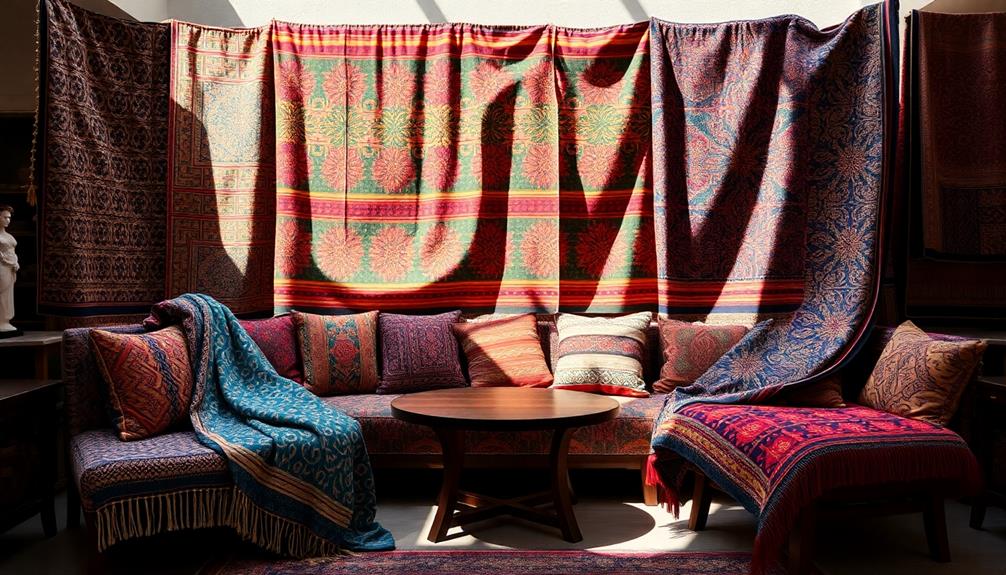
Endek textiles bring a burst of color and cultural depth to your home.
With their intricate patterns and traditional weaving techniques, these fabrics showcase the artistry of skilled Balinese artisans. Not only do they embody the spirit of Bali's design culture, but they also complement modern tropical aesthetics beautifully, making them perfect for enhancing spaces designed by experts in luxury tropical design aesthetics.
Each piece not only enhances your decor but also carries significant meanings tied to the rich heritage of the region.
Traditional Weaving Techniques
Celebrating Bali's rich cultural heritage, Endek embodies a traditional weaving technique that produces vibrant textiles brimming with intricate patterns.
This age-old method utilizes a backstrap loom, allowing you to control the tension and design of the fabric, leading to uniquely personalized pieces.
As you explore the world of Endek, you'll find that these textiles beautifully complement the traditional Indonesian style home decor, enhancing your living space with their unique charm.
Here are four key aspects to appreciate:
- Materials: Endek textiles are typically crafted from cotton or silk, ensuring both durability and beauty.
- Natural Dyes: The dyeing process incorporates natural pigments derived from plants, resulting in rich and lasting colors that are eco-friendly.
- Cultural Significance: Endek plays a crucial role in Balinese culture, often featured in ceremonial attire and reflecting community identity.
- Sustainable Practices: The revival of Endek weaving supports local artisans and promotes sustainable practices, providing income opportunities while preserving cultural heritage.
Incorporating Endek textiles into your home not only elevates its aesthetic but also celebrates the artistry and traditions of Bali.
Colorful Patterns and Designs
The vibrant patterns and designs of Endek textiles capture the essence of Bali's rich culture and natural beauty. Known for their intricate and colorful motifs, these traditional fabrics are created using a unique ikat weaving technique. Artisans dye the yarn before weaving, resulting in stunning patterns that reflect Bali's lush landscapes and complement the aesthetics of tropical contemporary architecture.
You'll find that Endek textiles often feature geometric motifs and floral designs, making them incredibly versatile for home decor, clothing, and accessories. The rich palette of colors, derived from natural dyes, adds warmth and character to any space.
When you incorporate Endek fabric into your home, whether it's through throw pillows, curtains, or wall hangings, you invite a touch of Indonesian artistry into your environment.
Each piece of Endek tells a story of craftsmanship and tradition passed down through generations of skilled artisans in Bali. The vibrant colors and intricate designs not only enhance your home's aesthetic but also connect you to a culture that values artistry and heritage.
Embracing Endek textiles will surely elevate your home's vibe, creating a welcoming and vibrant atmosphere.
Cultural Significance and Uses
Rooted in Balinese culture, Endek textiles serve not just as beautiful fabrics but also as symbols of community identity and pride.
These vibrant textiles reflect Bali's rich heritage, often seen in ceremonial attire and daily wear. The unique ikat weaving technique involves dyeing threads before weaving, resulting in stunning patterns that tell cultural stories. The use of traditional batik patterns within Endek designs further emphasizes the intricate artistry and cultural significance of these textiles.
Endek's significance extends beyond their aesthetic appeal; they serve various purposes in daily life and special occasions.
Here are some common uses of Endek textiles:
- Ceremonial Attire: Worn during traditional rituals and celebrations, showcasing the cultural heritage of the Balinese people.
- Home Decor: Ideal for adding artistic flair to spaces through pillow covers, curtains, and table runners.
- Fashion: Gaining popularity in modern clothing, blending traditional craftsmanship with contemporary style.
- Gifts: Often given as meaningful presents during special occasions, symbolizing good fortune and community connections.
Ulap Doyo: Natural Beauty

When you explore the world of Indonesian textiles, Ulap Doyo stands out for its natural beauty and sustainable qualities. Crafted from the fibers of the doyo tree, this fabric is known for its strength and resistance to pests, making it an eco-friendly choice for your home décor. The rich tapestry of earthy colors and patterns reflects the stunning landscapes of Indonesia, bringing a touch of nature indoors.
The weaving process is labor-intensive, often taking weeks to complete a single piece, showcasing the craftsmanship and cultural heritage of the region. You can use Ulap Doyo for various home décor applications, such as upholstery, cushions, and wall hangings, adding an exotic vibe to your space.
Here's a glimpse of what Ulap Doyo can offer:
| Aspect | Description | Emotion Evoked |
|---|---|---|
| Material | Durable doyo tree fibers | Strength and longevity |
| Color Palette | Earthy tones reminiscent of nature | Warmth and comfort |
| Craftsmanship | Labor-intensive, artisanal weaving | Appreciation for artistry |
Embrace Ulap Doyo's unique texture and durability to enhance both traditional and modern design aesthetics in your home.
Kain Perca: Patchwork Charm
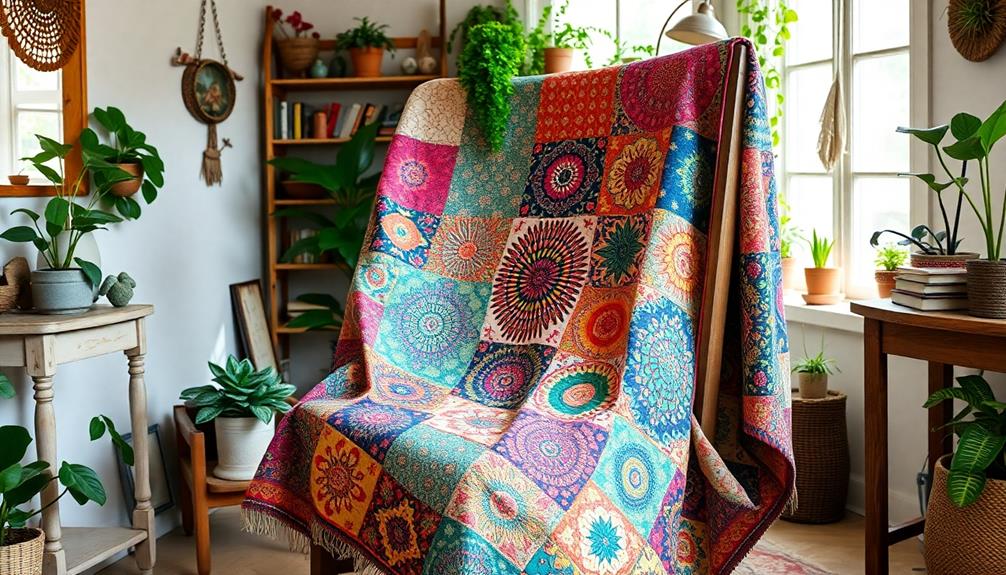
Kain Perca brings a unique textural appeal to your home with its vibrant patchwork of colors and patterns.
Each piece not only showcases the skill of Indonesian artisans but also carries deep cultural significance and heritage.
Unique Textural Appeal
How can a simple patchwork fabric transform your home into a vibrant haven? Kain Perca, with its lively colors and intricate designs, offers a unique textural appeal that can elevate your space.
Made from leftover fabric scraps, this traditional Indonesian textile embodies sustainability while showcasing creativity. Each piece is distinct, allowing you to personalize your decor effortlessly.
Here are four ways Kain Perca can enhance your home:
- Cushions: Add a pop of color to your living room with vibrant patchwork cushions that invite comfort and style.
- Wall Hangings: Create a stunning focal point by adorning your walls with Kain Perca art that tells a story through its patterns.
- Table Runners: Elevate your dining experience with a unique table runner that combines functionality with eclectic charm.
- Versatile Styles: Available in various styles and color palettes, Kain Perca fits seamlessly into both contemporary and traditional designs.
Cultural Significance and Heritage
The vibrant charm of Kain Perca goes beyond its visual appeal; it carries deep cultural significance and reflects the rich heritage of Indonesia. This traditional patchwork fabric showcases the creativity and resourcefulness of various Indonesian regions, as it's often crafted from remnants of other textiles. Each piece tells a story, representing centuries of artistic expression and social status through its unique patterns and colors.
You'll find that Kain Perca isn't just about aesthetics; it embodies sustainable practices in textile production. By repurposing fabric scraps that would otherwise be discarded, it contributes to eco-friendly living, making it a thoughtful choice for your home.
The local dyeing techniques and culturally significant motifs used in Kain Perca add layers of meaning to every creation, ensuring that no two pieces are alike.
As Kain Perca gains popularity in contemporary home decor, it evolves into beautiful cushions, quilts, and wall hangings, allowing you to infuse your space with Indonesian culture. By choosing Kain Perca, you're not just adding charm to your home; you're connecting with a rich heritage and supporting sustainable artistry.
Sumba Weaving: Artistry in Fabric
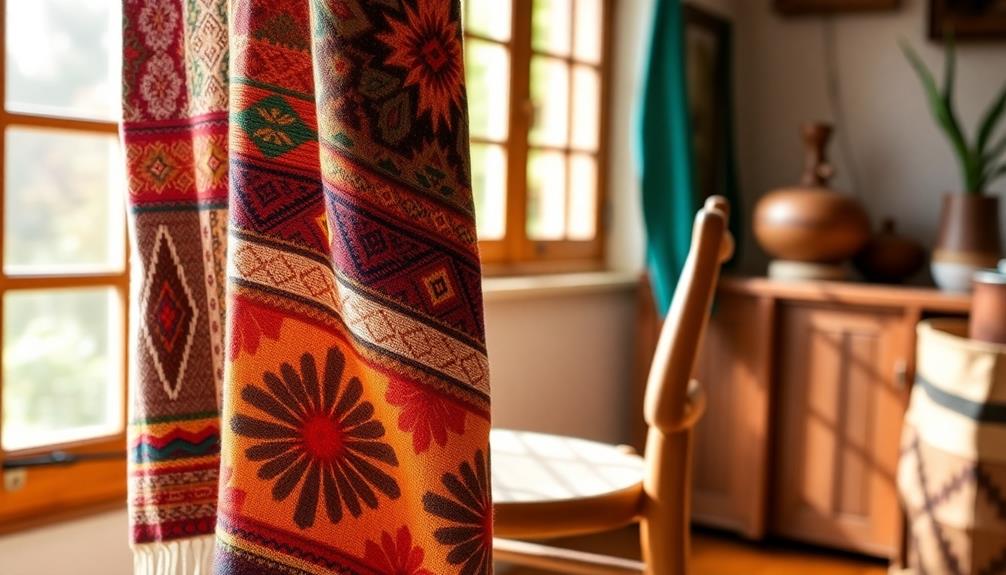
Sumba weaving represents a vibrant tapestry of cultural expression, showcasing the island's rich traditions through its intricate fabrics.
When you explore Sumba textiles, you'll discover their unique features that make them truly special:
- Intricate Patterns: Each piece boasts bold geometric designs that symbolize important themes like fertility, protection, and ancestral lineage.
- Natural Dyes: Artisans utilize dyes derived from local plants and minerals, resulting in vibrant colors that tell stories of the land and its people.
- Traditional Techniques: The weaving process is chiefly carried out on back-strap looms, allowing for precision and individuality in each textile.
- Cultural Heritage: The skills of Sumba weaving are passed down through generations of women, fostering cultural preservation and economic empowerment within the community.
Whether you're looking to add a statement piece to your home or searching for a unique gift, Sumba textiles won't only elevate your space but also connect you to the island's rich heritage.
Each fabric holds a narrative, inviting you to appreciate the artistry and tradition behind these stunning creations.
Lombok Textiles: Island Inspiration

In addition to the enchanting artistry of Sumba textiles, Lombok offers its own unique weaving traditions that reflect the island's vibrant spirit. Renowned for their rich colors and intricate patterns, Lombok textiles are traditionally handwoven, showcasing techniques passed down through generations. The most celebrated of these is Songket, a luxurious fabric often adorned with gold or silver threads, perfect for ceremonial attire.
Local artisans use natural dyes derived from plants and minerals, ensuring each piece embodies an environmentally friendly aesthetic. Geometric patterns, floral designs, and traditional symbols capture the essence of Lombok's history and beliefs, making these textiles not just beautiful but meaningful.
Here's a glimpse into the essence of Lombok textiles:
| Characteristic | Description | Emotional Impact |
|---|---|---|
| Vibrant Colors | Rich, eye-catching hues | Joy and warmth |
| Intricate Patterns | Detailed, unique designs | Connection to heritage |
| Natural Dyes | Eco-friendly materials | Peace of mind and respect |
| Ceremonial Use | Special occasions | Celebration and significance |
Balinese Offerings: Decorative Fabrics

While exploring the vibrant culture of Bali, you'll encounter decorative fabrics that play an essential role in daily offerings. One prominent example is the canang sari, featuring intricate designs and vibrant colors that reflect Bali's rich cultural heritage.
These textiles are typically hand-dyed and batiked, showcasing the traditional craftsmanship that Ubud is famous for. Each piece tells a unique story through its design.
Incorporating Balinese decorative fabrics into your home can greatly enhance its aesthetic appeal. Here are some ways to use them:
- Table Runners: Use them as stylish table runners during gatherings, adding a pop of color and cultural flair.
- Cushion Covers: Transform your living space with cushion covers made from these soft, luxurious fabrics.
- Wall Hangings: Create a focal point by displaying these unique textiles as wall art.
- Ceremonial Decor: Use them for special occasions, drawing on their spiritual significance and symbolism.
Frequently Asked Questions
How Do I Care for Indonesian Fabrics Properly?
To care for Indonesian fabrics properly, you should hand wash them in cold water with mild detergent, avoid direct sunlight when drying, and store them in a cool, dry place to maintain their vibrant colors.
Where Can I Buy Authentic Indonesian Textiles?
You can buy authentic Indonesian textiles at local markets, specialty boutiques, or online platforms like Etsy and Amazon. Always check reviews to guarantee quality, and consider visiting artisan cooperatives for unique, handmade options.
Are Indonesian Fabrics Suitable for Outdoor Use?
Indonesian fabrics can be fantastic for outdoor use if they're treated properly. Look for durable, weather-resistant options to guarantee they withstand the elements. You'll enjoy vibrant patterns and textures that brighten up any space!
Can I Use These Fabrics for Upholstery?
Yes, you can definitely use Indonesian fabrics for upholstery. Their vibrant patterns and durable materials make them a great choice for furniture. Just guarantee you choose fabrics specifically designed for upholstery to maintain longevity.
What Are the Origins of These Textile Techniques?
You'll discover these textile techniques trace back centuries, woven into Indonesia's rich cultural tapestry. Each method reflects local traditions and craftsmanship, creating fabrics that tell stories, inviting you to appreciate their history and beauty.
Conclusion
Incorporating these stunning Indonesian fabrics into your home is like adding a splash of vibrant color to a blank canvas. Each piece tells a story, infusing your space with culture and character. Whether you choose the timeless elegance of batik or the bold patterns of ikat, these textiles will effortlessly elevate your vibe. So go ahead, embrace the beauty of Indonesian craftsmanship and transform your home into a warm, inviting sanctuary full of life and inspiration.
